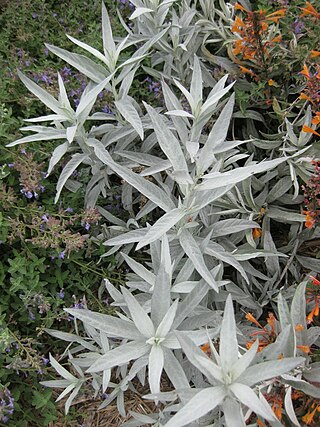Top Qs
Timeline
Chat
Perspective
Artemisia ludoviciana
Species of plant From Wikipedia, the free encyclopedia
Remove ads
Artemisia ludoviciana is a North American species of flowering plant in the daisy family Asteraceae, known by several common names, including silver wormwood, western mugwort, Louisiana wormwood, white sagebrush, lobed cud-weed, prairie sage, and gray sagewort.[1][2][3][4]

Ludoviciana is the Latinized version of the word Louisiana.[5]
Remove ads
Description
Artemisia ludoviciana is a rhizomatous perennial growing to heights of 0.3–1.0 m (0.98–3.28 ft). The stems bear linear leaves up to 11 cm long. The stems and foliage are covered in woolly gray or white hairs. The top of the stem is occupied by a narrow inflorescence of many nodding (hanging) flower heads. Each small head is a cup of hairy phyllaries surrounding a center of yellowish disc florets and is about 0.5 cm wide. The fruit is a minute achene. Flowers bloom July to October.[6]
Remove ads
Distribution and habitat
The plant is native to North America where it is widespread across most of the United States, Canada, and Mexico.[1][2][7][8] Some botanists suggest that eastern United States populations have been introduced from the western and central part of the continent.[9] Its habitats include dry slopes, canyons, open pine woods, and dry prairies.[6]
Subspecies
The following subspecies are recognised:[10]
- A. l. subsp. albula (Wooton) D.D.Keck—deserts from California and Colorado to Chihuahua, Sonora, Baja California
- A. l. subsp. candicans (Rydb.) D.D.Keck—Rocky Mountains and Cascade Range from Alberta, British Columbia to California, Colorado
- A. l. subsp. incompta (Nutt.) D.D.Keck—mountains from Alberta, British Columbia, to Mexico
- A. l. subsp. lindleyana (Besser) Lesica—Chihuahua, Sonora, Arizona
- A. l. subsp. ludoviciana—western and central United States and western Canada
- A. l. subsp. mexicana (Willd. ex Spreng.) D.D.Keck— Mexico as far south as Puebla; United States as far north as Colorado and Missouri
- A. l. subsp. redolens (A.Gray) D.D.Keck—Durango, Chihuahua, Arizona, New Mexico, Texas
Uses
Indigenous usage
Indigenous tribes across the continent use the species as a medicinal plant, a source of fiber for crafting household items, and for ceremonial purposes.[11] The Dakota people use this plant in smudging rituals to protect against maleficent spirits. The Apache, Chiricahua and Mescalero use it for spices,[12] while Blackfoot tribe use it as a drug for dermatological use.[13] The Cree and Blackfoot tribes use it in sweat lodges and the sun dance.[4] Gros Ventre also use it for skin curing and as medicine against cold, because it is also antipyretic.[14] The Meskwaki and Potawatomi use a tea made from this species as a treatment for sore throat and tonsillitis.[3]
Cultivation
A. ludoviciana is cultivated as an ornamental plant.[15] Being rhizomatous, it can spread aggressively in some climates and gardens. It grows in dry to medium moisture and well-drained soil. It requires full sun.[5]
Popular cultivars include 'Valerie Finnis' and 'Silver Queen'. Both are hardy to USDA zone 4. 'Valerie Finnis' has held the Royal Horticultural Society's Award of Garden Merit since 1993.[16]
Remove ads
References
External links
Wikiwand - on
Seamless Wikipedia browsing. On steroids.
Remove ads


